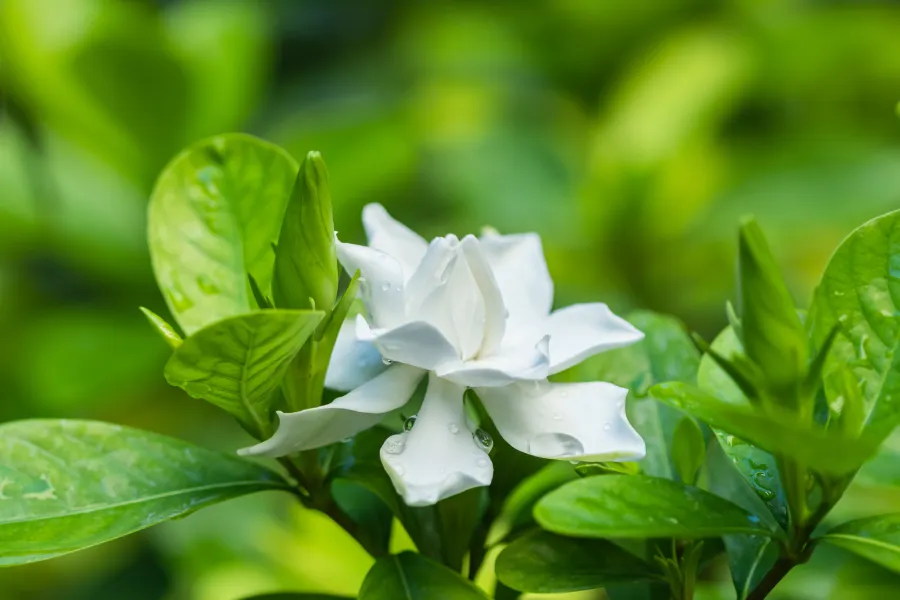
Gardenias
Gorgeous Gardenias
These classic shrubs are loved for the velvety white blooms and oh-so-intoxicating fragrance! They're evergreen so you'll enjoy their glossy green leaves year-round, and their flowers can withstand our stifling summer heat. If you're dreaming of a gardenia garden, read on for tips on how to plant and care for these scent-sational beauties.
Choosing a Gardenia
Before choosing which gardenia is right for your garden, you'll need to consider a few things:
- Sunlight. All gardenias need full sun to partial shade, so be sure you can plant them where they'll get at least 4 hours of direct sun per day. They thrive best with morning sun and afternoon shade for protection from the intense sun, especially in summer.
- Size. There are many varieties of gardenias with different mature sizes, so be sure to check labels before purchasing or ask Pike's knowledgeable associates for recommendations based on your space.
- Flower type. Some gardenias have single-blooms (with one row of petals), while others have double-blooms (with more petals) that almost looks like rose blooms. Both types are lovely and you can mix and match for variety in your garden.

Popular Varieties

'August Beauty'
This large, popular variety grows 4-6 feet tall and 3-4 feet wide; it'll make a great focal shrub or use for creating a hedge. Double blooms.

'Diamond Spire'
A relatively new variety with an upright, narrow growth habit that's perfect for container gardens. Grows 3-4 feet tall and 2 feet wide. Single blooms.

‘Frost Proof’
This variety is known for being more cold tolerant. Grows 4-5 feet tall and wide - an ideal size for a hedge or focal shrub. Single blooms.

‘Heaven Scent’
Grows 3-4 feet tall and wide, a medium size that works well for foundation plantings or near patios and walkways to enjoy the fragrance. Single blooms.

‘Jubilation’
Noted for its cold tolerance and long bloom time. Grows 3-4 feet tall and wide, good for hedges, foundation plantings, and mass plantings. Double blooms.

‘Radicans’
This
miniature variety reaches 1 foot tall and 2-3 feet wide. Spreading habit, great as a groundcover or a potted specimen. Small leaves and small double blooms.
How to Plant Gardenias
- Spring and fall are the best times to plant these shrubs when temperatures are mild. Gardenias benefit from slightly acidic soil. To ensure a well-draining, nutrient-rich foundation, amend your native clay soil with Pike Azalea & Camellia Soil for acid-loving plants.
- Dig a hole twice as wide as the pot the plant came in, and only as deep as the pot is tall. Gardenias don't like to be planted too deep; After digging the hole, add amended soil mixture to the bottom of the whole so that the plant's root ball will sit about one inch higher than the surrounding ground. This will ensure water drains away quickly. Fill in around the root ball with the amended soil mixture and add a 2-3 inch layer of mulch.
Care Tips
- Fertilizing - Feed gardenias once a year in late spring with an acidic fertilizer like Dr. Earth Acid Lovers or Espoma Holly-tone.
- Watering - Gardenias need about an inch of water a week. If there's no rain, get out your garden hose. Set a watering schedule to prevent your newly planted shrubs from drying out. Using a soaker hose connected to a faucet timer is easy and efficient. Once roots are well established, gardenias will have lower water needs.
- Pruning - Deadheading spent blooms throughout the season will encourage new flowers. If needed, prune gardenias after they finish blooming in the summer. Gardenias set flower buds in the fall, so pruning in the summer will allow you to cut back the plant without losing newly set buds.
- Weeding - Gardenias are shallow rooted, so avoid digging around the plant so you don't damage roots. Hand-pulling weeds is recommended over digging or tilling around these shrubs.
Aromatherapy Garden
Love the smell of gardenias? Here are some other plants you can pair with them to create your own aromatherapy garden.




